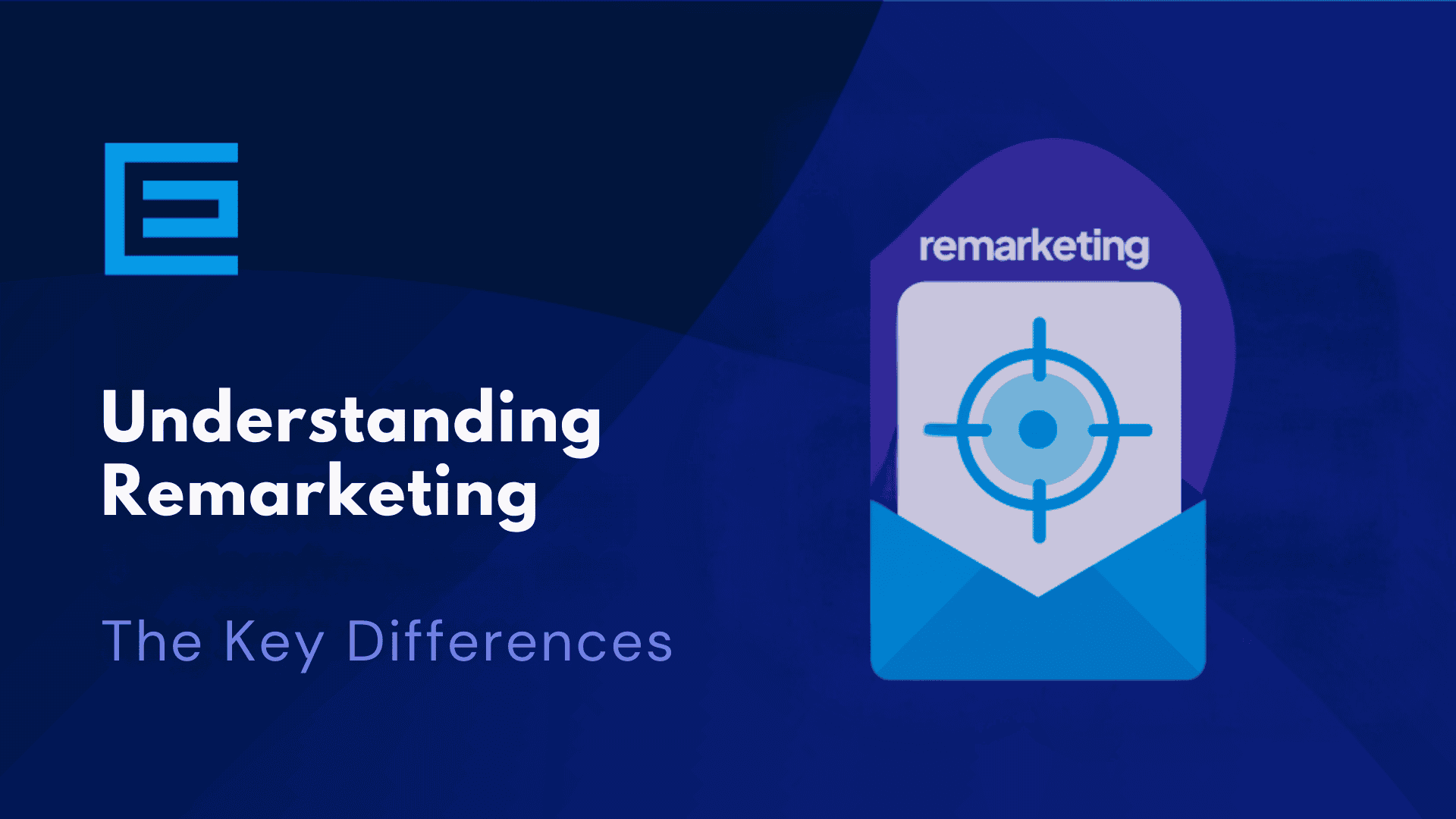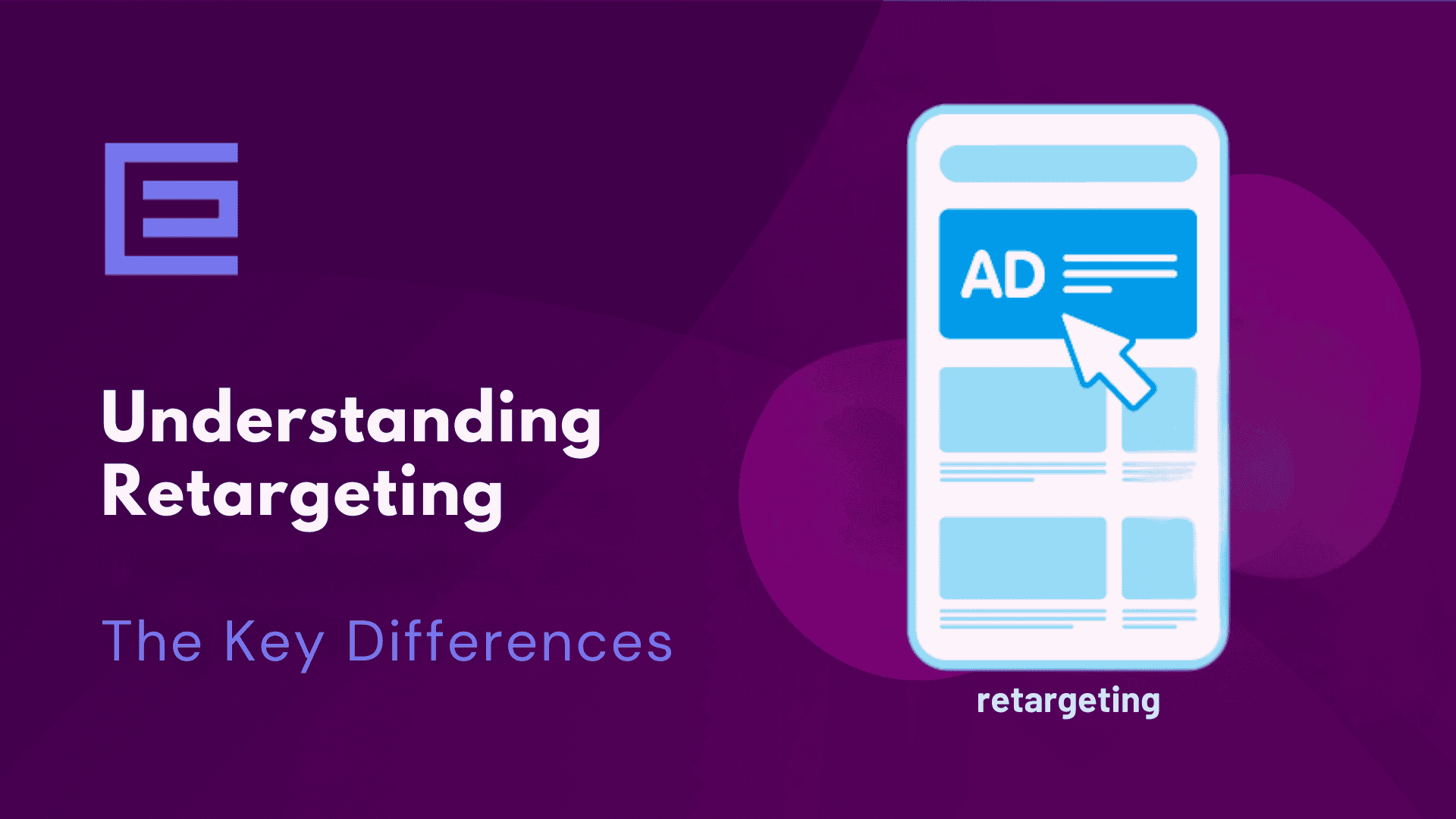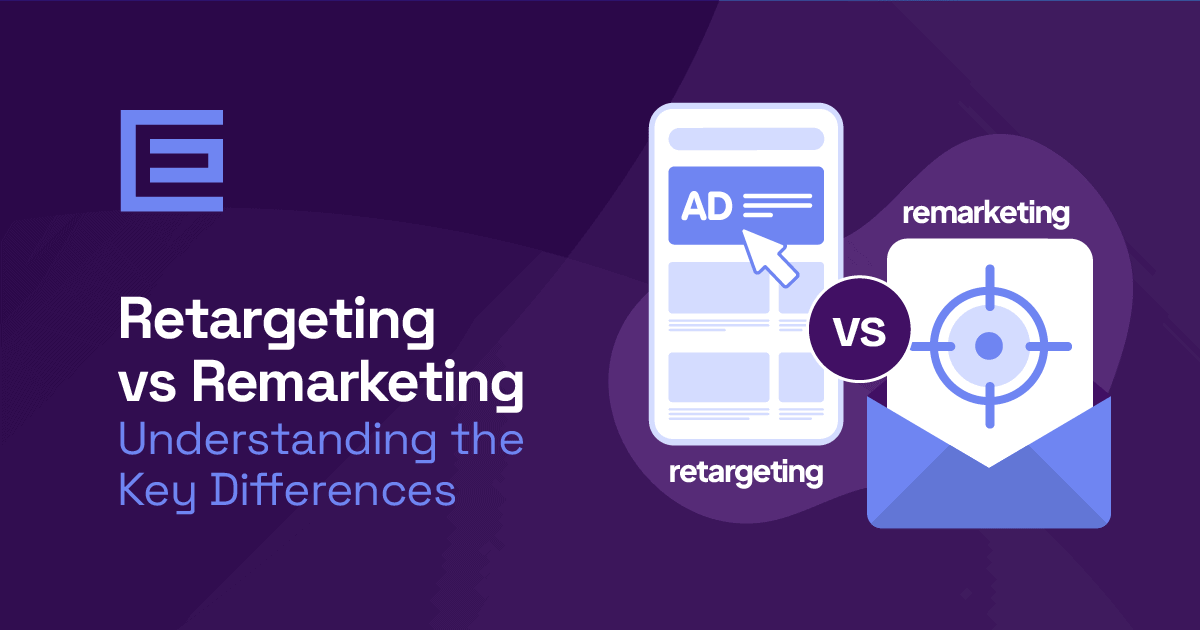How many people visit your website and wind up clicking the “Back” button over the “Buy”? Your paid ads are drawing in the traffic, but you’re consistently seeing abandoned carts and endless swells of new users. So, how do you stop users from leaving your site – never to be seen again? It starts with understanding the differences between remarketing vs retargeting in your social media and PPC campaigns.
- 96% of visitors leave without converting.
- 49% of those visitors come back 2-4 times before buying.
- Web traffic can increase by up to 700% with remarketing ads.
In this article, we’re going to break down remarketing vs retargeting. Then we’ll give you some tips on how to use both to drive more traffic and conversions to your website.
Let’s get started by looking at the difference between these two strategies.
Key Differences Between Remarketing and Retargeting
While remarketing and retargeting are both essential strategies in digital marketing for re-engaging potential customers, they differ significantly in their approach, methodology, target audience, channels used, and overall goals and objectives. Understanding these differences is important for marketers to effectively leverage each strategy for optimal results.
| Factor | Remarketing | Retargeting |
|---|---|---|
| Primary Channel | Paid Ads | |
| Targets Past Customers | ✔️ | ❌ |
| Targets Website Visitors | ❌ | ✔️ |
| Wide Reach | ❌ | ✔️ |
| High Engagement | ✔️ | ❌ |
| Approach | Personalized | Exposure Based |
| Use Cases | Follow-up Email | Product or Service Ad |
| Common Tools | Mailchimp, HubSpot | Google Ads, Facebook Pixel |
| Drives Conversions | ❌ | ✔️ |
| Drives Loyalty | ✔️ | ❌ |
Approach and Methodology
Remarketing is generally more relationship-driven, focusing on re-engaging customers who have previously interacted with your brand. Its approach is more personalized, often using direct communication methods to reach out to past customers or visitors. Remarketing campaigns typically involve collecting data through user interactions on websites or apps, which is then used to create targeted email campaigns or direct marketing efforts.
Retargeting, in contrast, is more about recapturing the attention of potential customers through repeated exposure. It primarily uses browser cookie-based technology to track users across the internet and serve them ads related to the products or services they viewed on your site. The methodology here is less about direct communication and more about maintaining visibility and top-of-mind awareness.
Target Audience
The target audience for remarketing is usually individuals who have already established a relationship with your brand. This could include past customers, email subscribers, or users who have engaged with your brand through various channels.
Retargeting, however, often targets users who have shown interest but have not necessarily engaged deeply with your brand. These are typically visitors who have browsed your website or interacted with your content but left without making a purchase or taking a specific desired action.
Channels Used (Email vs. Paid Ads)
Remarketing predominantly uses email as its main channel. This involves sending personalized emails to users based on their previous interactions, such as abandoned cart emails, customer loyalty offers, or follow-up messages after a purchase.
Retargeting mainly utilizes paid ads. These ads appear on other websites or social media platforms, targeting users who have visited your site. The ads are typically managed through platforms like Google AdWords or Facebook’s advertising system.
Goals and Objectives
The goals of remarketing are often centered around deepening customer relationships and increasing customer lifetime value. It aims to encourage repeat purchases, foster brand loyalty, and increase engagement among existing customers.
Retargeting, on the other hand, is primarily focused on increasing conversions by targeting potential customers who are already familiar with your brand but have not converted. The objective is to keep your brand visible to these users, nudging them towards making a purchase or completing a desired action.
In short, while both remarketing and retargeting aim to re-engage users, they do so in different ways and for different purposes. Remarketing is more about nurturing existing relationships through direct communication, while retargeting is about capturing potential customers through repeated exposure. Understanding these nuances is key to effectively implementing each strategy in your digital marketing efforts.
Understanding Remarketing

Remarketing is a powerful digital marketing strategy aimed at reaching individuals who have previously interacted with your brand, but did not complete a key action such as making a purchase. This technique involves sending targeted messages or content to these past visitors to encourage them to return and engage further with your brand.
Definition and Scope
Remarketing extends beyond mere advertising; it’s a strategic way to re-engage with people who already have some level of familiarity with your brand. This can be achieved through various channels, but email is the most common. Remarketing can also include direct mail, social media messages, or mobile notifications, depending on the data collected about the user’s previous interactions.
Key Strategies and Tools
Effective remarketing relies on a deep understanding of your audience and their behavior. Tools like Google Ads and Facebook Pixel are instrumental in tracking user activity on your website. Email marketing platforms like Mailchimp or HubSpot can be used to automate and personalize email campaigns based on user behavior, such as items left in a shopping cart or previously viewed products.
Use Cases and Examples
A classic example of remarketing is sending a follow-up email to a customer who abandoned their shopping cart. This email might include a special discount or a reminder of the items they were interested in. Another example is targeting users who have purchased a specific product with offers or information related to that product, enhancing cross-selling and upselling opportunities.
Benefits of Remarketing
Remarketing offers several key benefits:
- Increased Conversion Rates: By targeting individuals who have already shown interest in your products or services, remarketing can significantly increase the likelihood of conversions.
- Personalized Marketing: It allows for tailored messages that resonate more with the audience, based on their previous interactions with your brand.
- Brand Recall and Loyalty: Regular, targeted communication helps keep your brand top-of-mind, encouraging repeat purchases and fostering brand loyalty.
- Cost-Effectiveness: Since you’re targeting users who are already familiar with your brand, the cost per acquisition is often lower compared to acquiring new customers.
In summary, remarketing enables businesses to maintain a connection with potential customers who are already partway through the sales funnel, increasing the chances of turning these leads into loyal customers.
Understanding Retargeting

Retargeting is designed to target users who have previously visited your website or interacted with your brand online but did not complete a conversion action. This technique is pivotal in recapturing the attention of potential customers and guiding them back to complete a purchase or another desired action.
Definition and Scope
Retargeting primarily operates through online ads. It involves tracking visitors to your website and then displaying your ads to these visitors as they browse other sites online. The scope of retargeting is vast, encompassing various digital platforms including social media, mobile apps, and other websites. It’s a strategy that works on the principle of reminding and persuading users about your products or services, leveraging their prior interest.
Key Strategies and Tools
Successful retargeting campaigns require precise targeting and timing. Tools like Google AdWords and Facebook’s retargeting feature enable businesses to place cookies on their website. These cookies track the site visitors and then serve them targeted ads based on their browsing behavior and interaction with your site. The use of dynamic retargeting ads can further enhance this strategy by showing specific products or content that the user viewed.
Use Cases and Examples
A common use case for retargeting is targeting users who visited your site and left without making a purchase. For instance, if a user browses a pair of shoes on an e-commerce site but leaves without buying, retargeting can be used to show ads for those shoes on other websites they visit later. Another example is retargeting ads for a webinar or an event to users who visited the registration page but did not sign up.
Benefits of Retargeting
Retargeting offers several compelling benefits:
- Higher Conversion Rates: By targeting users who have already shown interest in your products or services, retargeting often achieves higher conversion rates compared to other advertising methods.
- Improved Brand Recognition: Continuous exposure to your brand increases recognition and keeps your brand at the forefront of potential customers’ minds.
- Customized Messaging: Retargeting allows for highly personalized ad content, tailored to the specific interests and past behavior of users.
- Cost-Effective Reach: Since retargeting focuses on users who have already visited your website, it often results in a more efficient use of advertising budgets.
In summary, retargeting effectively capitalizes on existing interest, nudging potential customers who are already familiar with your brand back towards making a purchase or engaging with your brand in a meaningful way.
Remarketing vs Retargeting Key Differences
How Remarketing and Retargeting Complement Each Other
Remarketing and retargeting, while distinct in their approaches, can be highly complementary when integrated into a cohesive marketing strategy. Their combined use can create a more dynamic and effective approach to customer engagement and conversion.
Integrated Marketing Strategies
The integration of remarketing and retargeting strategies allows for a more comprehensive approach to digital marketing. Remarketing can be used to deepen relationships with existing customers or users who have shown a high level of engagement while retargeting can focus on those who have demonstrated interest but need further nudging to convert.
For instance, a user who visited a website and left without purchasing can be first targeted with retargeting ads across different platforms to maintain brand awareness and product recall. Following this, if the user engages with these ads or revisits the site, remarketing strategies like personalized email campaigns can be employed to provide a more direct and tailored message, encouraging them to complete the purchase.
This integrated approach ensures that potential customers are not just repeatedly exposed to the brand, but are also engaged through personalized communication, increasing the likelihood of conversion.
Use Cases for using both Remarketing and Retargeting
Several businesses have successfully leveraged the combination of remarketing and retargeting to boost their marketing results. Here are some examples of how they can be used for different industries.
- E-commerce: An online retailer implemented retargeting ads to reach users who visited their site without making a purchase. These ads resulted in a significant number of return visits. The retailer then used remarketing emails, offering special discounts and personalized product recommendations to these return visitors, which led to a marked increase in conversions.
- Service Industry: A travel agency used retargeting to keep their offers in front of users who visited their site but did not book a trip. After a period of retargeting through display ads, the agency followed up with remarketing emails that provided additional information and exclusive deals on travel packages the users had shown interest in. This strategy resulted in a higher booking rate compared to using either approach in isolation.
- B2B Case: A software company used retargeting to maintain brand visibility among users who downloaded their free trial but did not purchase the full product. After a few weeks of retargeting with educational content and testimonials, they employed remarketing through personalized emails, addressing specific user needs and offering tailored solutions. This approach led to an increase in software purchases from trial users.
In each of these cases, the combination of retargeting and remarketing strategies allowed businesses to first recapture the attention of potential customers and then engage them on a more personal level, leading to improved conversion rates. By covering different stages of the customer journey and addressing various levels of customer engagement, these integrated strategies provide a more holistic approach to digital marketing.
Best Practices in Remarketing and Retargeting

To maximize the effectiveness of remarketing and retargeting strategies, it’s essential to adhere to certain best practices. These practices not only enhance the efficiency of your campaigns but also ensure a positive experience for your target audience, ultimately leading to higher conversion rates.
Tips for Effective Remarketing
- Segment Your Audience: Tailor your remarketing campaigns by segmenting your audience based on their behavior. For example, send different messages to users who abandoned their cart than to those who made a purchase.
- Personalize Your Messages: Use the data you have on your customers to personalize your emails. Personalization can range from addressing the customer by name to recommending products based on their browsing history.
- Timing is Key: The timing of your remarketing emails can significantly impact their effectiveness. For instance, sending a cart abandonment email within 24 hours can prompt a customer to complete their purchase.
- Offer Incentives: Incentives like discounts, free shipping, or exclusive offers can encourage users to return to your website and complete a purchase.
- Test and Optimize: Continuously test different aspects of your remarketing campaigns, such as email subject lines, content, and sending times, and optimize based on performance metrics.
Tips for Successful Retargeting
- Use Frequency Caps: To avoid overwhelming your audience, set frequency caps on how often a user sees your ad. This prevents ad fatigue and maintains a positive brand perception.
- Create Compelling Ad Content: Your retargeting ads should be visually appealing and have a clear call-to-action. Ensure that your ads are relevant to the user’s previous interactions with your site.
- Leverage Dynamic Retargeting: Use dynamic retargeting to show ads that feature products or services that the user has previously viewed, making the ads more relevant and personalized.
- Optimize for Different Platforms: Tailor your retargeting ads for different platforms. The ad that works on Facebook might not perform the same way on Google or Instagram.
- Track and Analyze Performance: Regularly monitor the performance of your retargeting campaigns. Use analytics to understand what’s working and make data-driven adjustments.
Common Pitfalls to Avoid
- Overexposure: Bombarding users with too many ads can lead to negative feelings towards your brand. Balance is crucial in retargeting.
- Ignoring Privacy Concerns: Always be mindful of privacy regulations like GDPR. Ensure that your retargeting practices are compliant with these laws.
- Neglecting Mobile Users: With the increasing use of mobile devices, ensure that your retargeting ads are optimized for mobile.
- Failing to Refresh Ad Content: Regularly update your ad creatives to keep the content fresh and engaging for users who have not yet responded.
- Overlooking the Post-Conversion Experience: Don’t stop your efforts once a conversion is made. Post-conversion remarketing can turn one-time buyers into loyal customers.
By following these best practices and avoiding common pitfalls, you can create more effective and efficient remarketing and retargeting campaigns that resonate with your audience and drive conversions.
FAQs
What is more effective: remarketing or retargeting?
The effectiveness of remarketing versus retargeting largely depends on your specific business goals and the nature of your audience. Remarketing is highly effective for re-engaging past customers and deepening relationships with users who have already shown a significant interest in your products or services. It’s particularly useful for increasing customer retention and lifetime value. On the other hand, retargeting is more effective for capturing the attention of users who have shown initial interest but have not yet engaged deeply with your brand, making it ideal for increasing brand awareness and conversion rates. Ultimately, the choice between the two should be based on your campaign objectives and the stage of the customer journey you are targeting.
Can remarketing and retargeting be used together?
Yes, remarketing and retargeting can be used together, and doing so can be highly beneficial. When integrated into a comprehensive marketing strategy, they complement each other by covering different aspects of the customer journey. Retargeting can be used to initially recapture the attention of potential customers, while remarketing can follow up with more personalized and direct communication. This combined approach ensures that potential customers are not only reminded of your brand but are also engaged through tailored messaging, increasing the likelihood of conversion.
How do I choose between remarketing and retargeting for my business?
Choosing between remarketing and retargeting depends on your specific marketing goals and the audience you are trying to reach. If your goal is to re-engage customers who have already made a purchase or shown a high level of interest, remarketing is the way to go. It’s ideal for businesses looking to increase customer loyalty and repeat purchases. If your objective is to increase conversions by targeting users who have visited your website but left without taking any action, retargeting would be more appropriate. It’s especially effective for businesses looking to expand their customer base and increase brand awareness. Analyzing your sales funnel and customer behavior can help determine which strategy aligns best with your business objectives.
What are some common tools used for remarketing and retargeting?
Several tools are available for executing remarketing and retargeting campaigns effectively. For remarketing, email marketing platforms like Mailchimp, HubSpot, and Constant Contact are popular choices. They offer features for segmenting audiences, personalizing emails, and automating campaigns. For retargeting, Google Ads and Facebook Pixel are widely used. These platforms allow you to place cookies on your website to track visitors and then serve them targeted ads based on their browsing behavior. Additionally, tools like AdRoll and Criteo specialize in retargeting across various digital platforms, offering advanced targeting and optimization features. Choosing the right tools depends on your specific needs, budget, and the complexity of your campaigns.
Final Word: Remarketing vs Retargeting

When it comes to choosing between remarketing and retargeting, the decision should be based on your specific business objectives and the stage of the customer journey you are targeting. Remarketing is ideal for nurturing existing relationships and maximizing customer lifetime value, while retargeting is more suited for increasing brand awareness and driving new conversions.
Incorporating both strategies into your digital marketing plan can create a more comprehensive approach. By using retargeting to bring potential customers back to your site and remarketing to build and maintain a deeper connection with them, you can effectively cover different stages of the customer journey, enhancing the overall effectiveness of your marketing efforts.
Ultimately, the key to success in digital marketing lies in understanding your audience, clearly defining your goals, and using the right mix of strategies to achieve them. Whether you choose remarketing, retargeting, or a combination of both, the goal remains the same: to engage effectively with your audience and drive meaningful conversions. By doing so, you can not only increase your immediate sales but also build a foundation for long-term customer loyalty and sustained business growth.
Fields marked with an asterisk (*) are required.
Your information is collected for the sole purpose of providing services described on this website.
Your private information is held in strict confidence. We will never release, share or sell your information to any other entities. We hate spam too!
Tags: Digital Marketing • Paid Search Marketing • Social Media Marketing Tips • Strategy & Consulting







